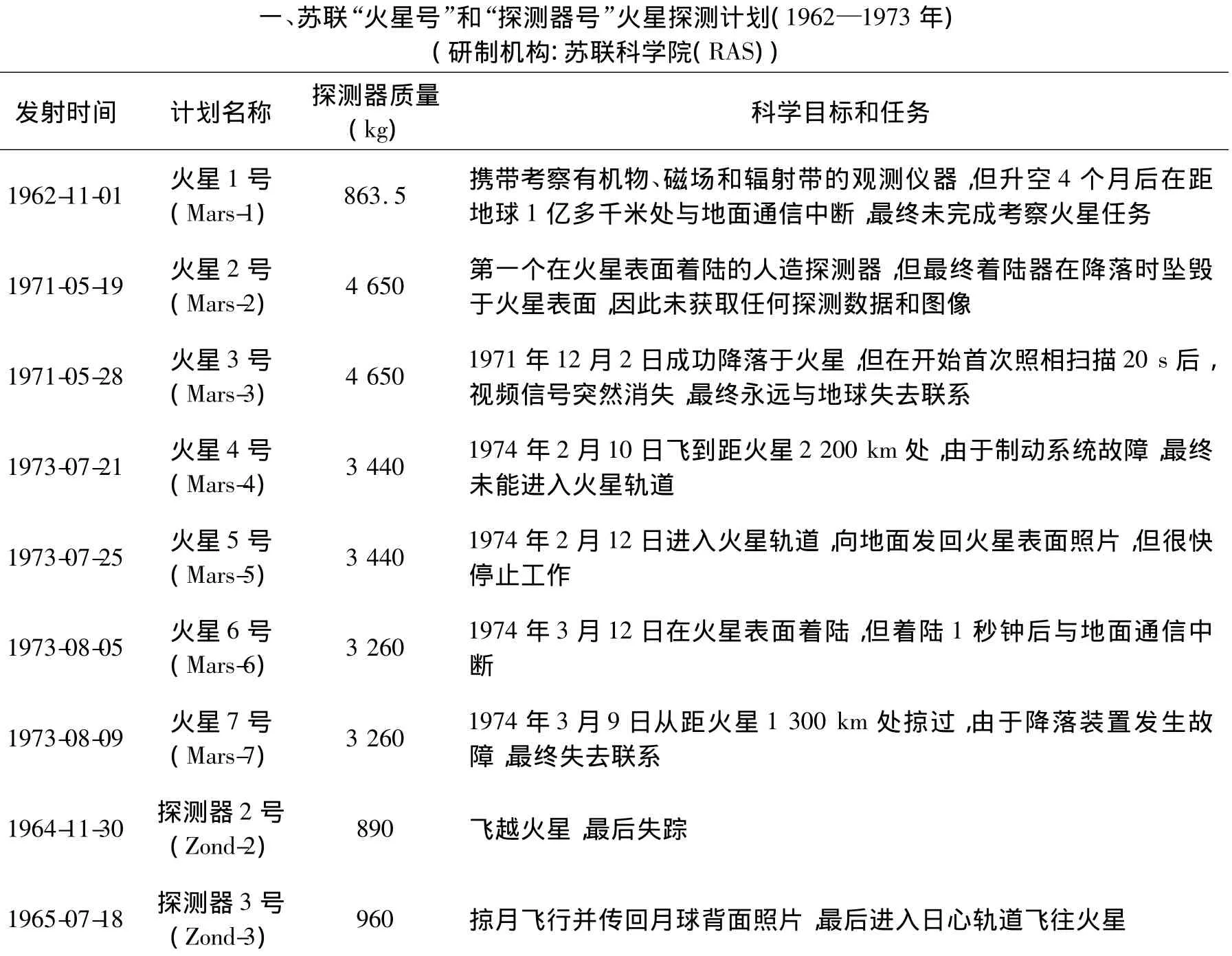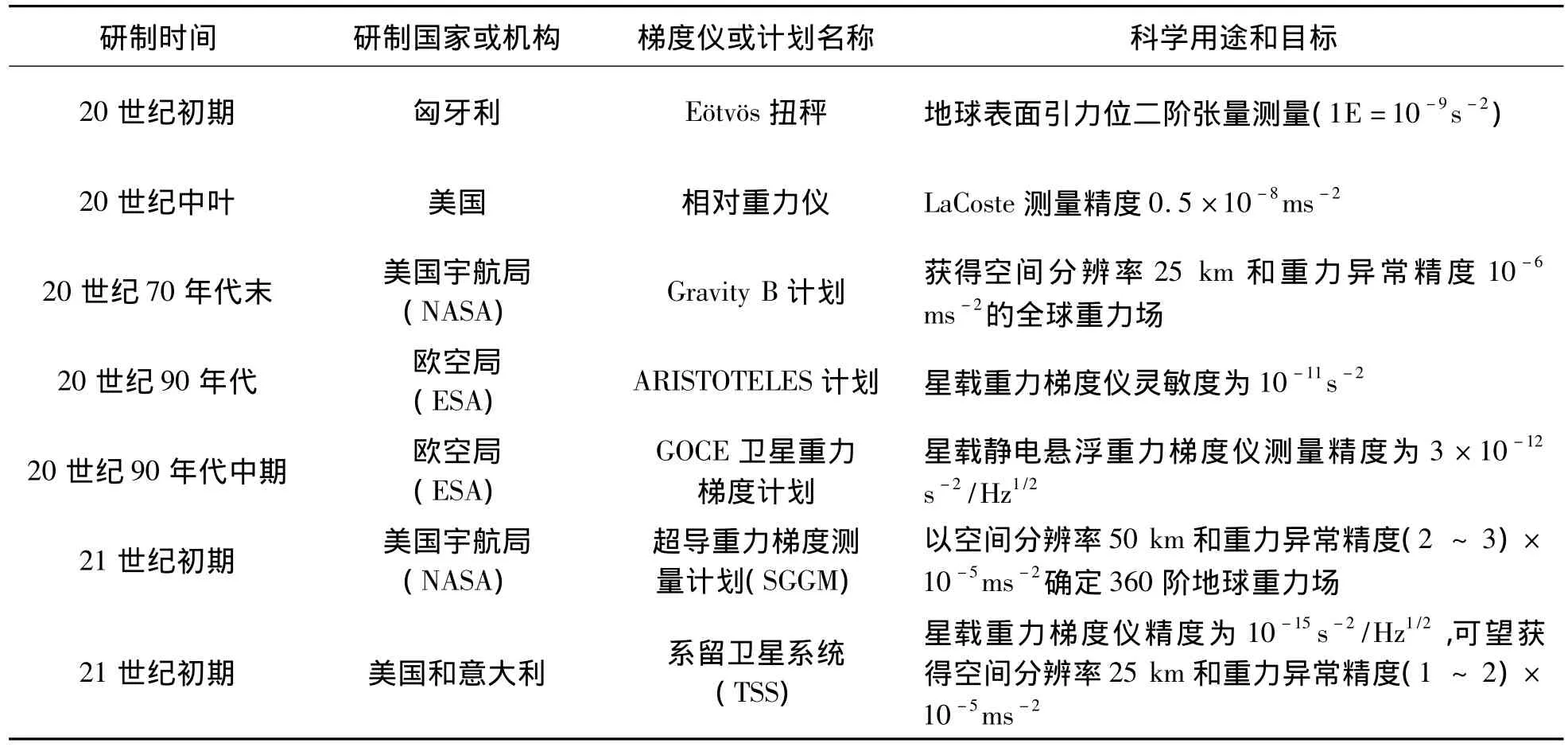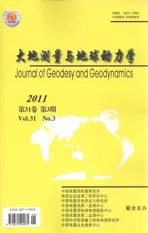国际火星探测计划进展和中国火星卫星重力测量计划研究*
2011-09-20郑伟许厚泽钟敏员美娟
郑伟 许厚泽 钟敏 员美娟
1)中国科学院测量与地球物理研究所动力大地测量学重点实验室,武汉4300772)日本京都大学防灾研究所,京都611-0011日本3)武汉科技大学应用物理系,武汉430081
国际火星探测计划进展和中国火星卫星重力测量计划研究*
郑伟1,2)许厚泽1)钟敏1)员美娟3)
1)中国科学院测量与地球物理研究所动力大地测量学重点实验室,武汉430077
2)日本京都大学防灾研究所,京都611-0011日本
3)武汉科技大学应用物理系,武汉430081
介绍国际火星探测计划和基于国际火星探测数据建立的火星重力场模型,阐述SGG-Doppler-VLBI跟踪观测模式的测量原理和优点,并建议中国将来首期火星卫星重力测量计划采用SGG-Doppler-VLBI观测模式和静电悬浮重力梯度仪。
火星探测计划;卫星重力梯度;火星重力场模型;卫星跟踪模式;重力梯度仪
AbstractThe implemented international Martian exploration programs including“Mars,Zond and Phobos-1/ 2”in USSR,“Mariner,Viking,Mars Observer,Mars Global Surveyor,Mars Pathfinder,Mars Climate Orbiter,Mars Polar Lander,Mars Odyssey,Spirit,Opportunity,Mars Reconnaissance Orbiter and Phoenix”in USA,“Mars-96”in Russia,“Hope”in Japan and“Mars Express”in Europe,and the future domestic and overseas Martian measurement missions are presented.The Martian gravitational field models produced by Martian observations are introduced amply,which including.1)the U.S.:6×4,6×6,10×10,Mars50c,MGS75B,MGS75D/ E,MGS85F/F2/H2,MGS95I/J,GMM-1,GMM-2B,GGM1025 and GGM1041C.2)the U.K.:6×6.3)France:18×18 and MGGM08A.The measuring principle and advantages in the SGG-Doppler-VLBI tracking mode are described,which will be applied in the future first-stage China’s Martian satellite gravity measurement.It is concluded that the electrostatic suspension gravity gradiometer is preferable in the future first-stage Martian satellite gravity gradiometry mission in China by a comparison of strongpoints and shortcomings from electrostatic suspension,superconducting and quantum gravity gradiometers.
Key words:Martian exploration mission;satellite gravity gradiometry;Martian gravitational field model;satellite tracking mode;gravity gradiometer
1 引言
火星重力场的精密测量是国际火星探测计划的重要组成部分,决定着火星探测器轨道的优化设计和载人登火飞船在火星表面理想着陆点的最优选取。重力探测卫星在重力场作用下绕火星作近圆极轨运动,若精密定轨必须知道精确的火星重力场参数;反之,精确测定卫星轨道摄动,利用摄动跟踪观测数据又可以提高火星重力场参数的精度。因此,确定火星重力场的精细结构不仅是测绘科学、宇航科学、行星科学、天文科学、空间科学、生命科学等的需求,同时也将为全人类开展火星地形地貌和内部结构研究、火星新能源和资源探测、火星表面宇宙环境分析、火星系统起源和演化历史论证等提供重要和丰富的信息资源。
目前国内外测绘和航天等领域的众多科学研究者已围绕火星探测开展了广泛而深入的研究[1-24]。为积极推动我国自主火星卫星重力测量计划的早日实施,加快我国研制火星重力卫星的步伐,提出了我国将来火星卫星重力梯度(SGG)计划的实施建议。
2 国际火星探测计划发展历程
国际火星探测计划按发展历程可分为二期,各自的科学目标和任务见表1和表2。
火星重力场模型是指火星引力位按球谐函数展开中引力位系数的集合。自20世纪60年代苏联和美国开始发射火星探测器以来,国际众多研究机构已采用多种技术和方法进行了广泛的火星重力场测量(表3)。
3 中国火星卫星重力梯度计划研究
3.1 SGG-Doppler-VLBI观测模式的原理
SGG-Doppler-VLBI观测系统由地面Doppler-VLBI系统和低轨火星重力梯度卫星组成(图1)。其测量原理如下:利用地面Doppler-VLBI观测系统对低轨火星重力梯度卫星精密跟踪定位,通过星载重力梯度仪直接测定火星卫星轨道高度处引力位的二阶微分,基于非保守力补偿系统屏蔽火星重力梯度卫星受到的非保守力,利用姿态和轨道控制系统测量卫星和载荷的空间三维姿态,最后联合上述火星卫星重力梯度观测值高精度和高空间分辨率反演火星重力场。

图1 SGG-Doppler-VLBI的测量原理Fig.1Measuring principle of SGG-Doppler-VLBI
3.2 卫星重力梯度仪的选取
20世纪初以来,重力梯度仪的研究经历了从单轴旋转到三轴定向,从室温到超低温(<4.2 K),从扭力、静电悬浮到超导的发展过程,仪器灵敏度日益提高(表4)。扭力测量通过测定作用于检测质量的力矩来间接获取重力梯度值;差分加速度测量通过测量两加速度计之间的加速度差来获得重力梯度观测值,可消除加速度计之间大部分公共误差的影响,因此较前者更有发展前景。
目前卫星重力梯度仪主要包括旋转式重力梯度仪、静电悬浮重力梯度仪、超导重力梯度仪、量子重力梯度仪等。静电悬浮重力梯度仪我国已具有一定的研究基础,而且可借鉴地球重力梯度卫星GOCE星载静电悬浮重力梯度仪的成功经验,因此建议我国首期火星卫星重力梯度计划采用静电悬浮重力梯度仪高精度和高空间分辨率感测中高频火星重力场。基于超导重力梯度仪和量子重力梯度仪可超高精度感测火星重力重力场但研制困难较大的原因,建议我国研究机构尽快开展预先研制,以期尽早应用于后期火星卫星重力梯度计划。
综上所述,SGG-Doppler-VLBI是一项探测火星重力场特性特征、精细结构和演变过程的新技术和新领域。目前已逐渐发展成为专门研究火星重力梯度测量的理论、方法、载荷和应用的新兴科学,而且
星载重力梯度仪可直接测定引力位的二阶导数进而有效抑制火星重力场中高频信号的衰减效应,因此SGG-Doppler-VLBI观测模式有望成为我国将来优选的和具有发展潜力的火星卫星重力测量模式之一。

表1 国际第一期火星探测计划发展历程[25,26]Tab.1Progress of the international first-stage Martian exploration programs

二、美国“水手号”和“海盗号”探测计划(1964—1975年) (研制机构:美国航空航天局(NASA))

表2 国际第二期火星探测计划[25-32]Tab.2Progress of the international second-stage Martian exploration programs
致谢感谢罗俊院士的帮助,以及中国国家航天局、美国航空航天局、俄罗斯联邦航天局、日本宇宙航空研究开发机构、欧洲空间局、印度空间研究组织、英国国家太空中心等研究机构提供了火星探测的相关资料。

(续表2)

表3 火星重力场模型研究Tab.3Research progress of the Martian gravitational field models

表4 重力梯度仪研究[46]Tab.4Research progress of the gravity gradiometers
1Anderson J D,Efron L and Wong S K.Martian mass and Earth-moon mass ratio from coherent S-band tracking of Mariner 6 and 7[J].Science,1970,167(3916):227-279.
2Pettengill G H,Rogers A E E and Shapiro I I.Martian craters and a scarp as seen by radar[J].Science,1971,174 (4016):1 321-1 324.
3Sjogren W L,Lorell J and Wong L.Mars gravity field based on a short-arc technique[J].Journal of Geophysical Research,1975,80(20):2 899-2 908.
4Reasenberg R D and King R W.The rotation of Mars[J].Journal of Geophysical Research,1979,84:6 231-6 240.
5Chao B F and Rubincam D P.Variations of Mars gravitational field and rotation due to seasonal CO2 exchange[J].Journal of Geophysical Research,1990,95(B9):14 755-14 760.
6Kolyuka Y F,Efimov A E and Kudryavtsev S M.Refinement of the gravitational constant of Phobos from Phobos 2 tracking data[J].Soviet Astronomy Letters,1990,16:168–170.
7Folkner W M,Kahn R D and Preston R A.Mars dynamics from Earth-based tracking of the Mars Pathfinder lander[J].Journal of Geophysical Research,1997,102:4 057-4 064.
8Folkner W M,Yoder C F and Yuan D N.Interior structure and seasonal mass redistribution of Mars from radio tracking of Mars Pathfinder[J].Science,1997,278:1 749-1 752.
9Yoder C F and Standish E M.Martian precession and rotation from Viking lander range data[J].Journal of Geophysical Research,1997,102:4 065-4 080.
10Smith D E,Sjogren W L and Tyler G L.The gravity field of Mars:results from Mars global surveyor[J].Science,1999,286:94-97.
11Carranza E,Yuan D N and Konopliv A S.Mars global surveyor orbit determination uncertainties using high resolution Mars gravity models[A].In:Spencer D B,Seybold C C,Misra A K,Lisowski R J(Eds.),Advances in the Astronautical Sciences,vol.109[C].Univelt,San Diego,CA,2001,1 633-1 650.
12Smith D E,Zuber M T and Neumann G A.Seasonal variations of snow depth on Mars[J].Science,2001,294: 2 141-2 146.
13Neumann G A,Zuber M T and Wieczorek M A.Crustal structure of Mars from gravity and topography[J].Journal of Geophysical Research,2004,109,doi:10.1029/ 2004JE002262.E08002.
14Karatekin O,Duron J and Rosenblatt P.Mars’time-variable gravity and its determination:simulated geodesy experiments[J].Journal of Geophysical Research,2005,110 (E6),E06001.
15Konopliv A S,Yoder C F and Standish E M.A global solution for the Mars static and seasonal gravity,Mars orientation,phobos and deimos masses,and Mars ephemeris[J].Icarus,2006,182:23-50.
16Sanchez B V,Rowlands D D and Haberle R M.Variations of Mars gravitational field based on the NASA/Ames general circulation model[J].Journal of Geophysical Research,2006,111,E06010,doi:10.1029/2005JE002442.
17陈昌亚,等.YH-1火星探测器设计及研制进展[J].上海航天,2009,26(3):21-25.(Chen Changya,et al.The design features and research processing of YH-1 Mars probe[J].Aerospace Shanghai,2009,26(3):21-25)
18吴季,等.萤火一号火星探测计划的科学目标[J].空间科学学报,2009,29(5):449–455.(Wu Ji,et al.Overview of scientific objectives of China-Russia Joint Mars exploration program YH-1[J].Chinese Journal of Space Science,2009,29(5):449-455)
19鄢建国,平劲松.火星重力场研究现状及发展趋势[J].物理,2009,38(10):707–711.(Yan Jianguo and Ping Jingsong.A gravity field model for Mars[J].Physics,2009,38(10):707-711)
20郑伟,许厚泽,钟敏.Mars-SST火星卫星重力测量计划研究[J].测绘科学,2012,待发表.(Zheng Wei,Xu Houze and Zhong Min.Research on Mars-SST satellite gravity measurement mission[J].Science of Surveying and Mapping,2012,to be published)
21郑伟,许厚泽,钟敏.卫-卫跟踪测量模式中轨道高度的优化选取[J].大地测量与地球动力学,2009,(2): 100-105.(Zheng Wei,Xu Houze and Zhong Min.Optimal design of orbital altitude in satellite-to-satellite tracking model[J].Journal of Geodesy and Geodynamics,2009,(2):100-105)
22郑伟,许厚泽,钟敏.地球重力场模型研究进展和现状[J].大地测量与地球动力学,2010,(4):83-91.(Zheng Wei,Xu Houze and Zhong Min.Progress and present status of the research on Earth’s gravitational field models[J].Journal of Geodesy and Geodynamics,2010,(4):83-91)
23郑伟,许厚泽,钟敏.Improved-GRACE卫星重力轨道参数优化研究[J].大地测量与地球动力学,2010,(2):43-48.(Zheng Wei,Xu Houze and Zhong Min.Research on optimal selection of orbital parameters in the Improved-GRACE satellite gravity measurement mission[J].Journal of Geodesy and Geodynamics,2010,30(2): 43-48)
24郑伟,许厚泽,钟敏.基于激光干涉星间测距原理的下一代月球卫星重力测量计划需求论证[J].宇航学报,2011,34(4):922-932.(Zheng Wei,Xu Houze and Zhong Min.Demonstration of requirement on future lunar satellite gravity exploration mission based on interferometric laser intersatellite ranging principle[J].Journal of Astronautics,2011,34(4):922-932)
25http://www.federalspace.ru,the Official Website of Russian Federal Space Agency,2011.
26http://www.nasa.gov,the Official Website of National Aeronautics and Space Administration,2011.
27http://www.jaxa.jp,the Official Website of Japan Aerospace Exploration Agency,2011.
28http://www.esa.int,the Official Website of European Space Agency,2011.
29http://www.bis.gov.uk,the Official Website of UK Space Agency,2011.
30http://www.cnsa.gov.cn,the Official Website of China National Space Administration,2011.
31http://www.fmi.fi/en,the Official Website of Finnish Meteorological Institute,2011.
32http://www.isro.org,the Official Website of Indian Space Research Organization,2011.
33Lorell J,Born G H and Christensen E J.Gravity field of Mars from Mariner 9 tracking data[J].Icarus,1973,18: 304-316.
34Born G H.Mars physical parameters as determined from Mariner 9 observations of the natural satellites and Doppler tracking[J].Journal of Geophysical Research,1974,79: 4 837-4 844.
35Konopliv A S and Sjogren W L.The JPL Mars Gravity Field,Mars50c,based upon Viking and Mariner 9 Doppler Tracking Data[A].JPL Publication 95-5[C].Jet Propulsion Laboratory,Pasadana,Ca.,1995.
36Yuan D N,Sjogren W L and Konopliv A S.Gravity field of Mars:A 75th degree and order model[J].Journal of Geophysical Research,2001,106:23 377-23 401.
37Planetary Data System Geosciences Node(http://wwwpds.wustl.edu).
38Konopliv A S,Yoder C F and Standish E M.A global solution for the Mars static and seasonal gravity,Mars orientation,Phobos and Deimos masses,and Mars ephemeris[J].Icarus,2006,182(1):23-50.
39Reasenberg R D,Shapiro I I and White R D.The gravity field of Mars[J].Geophysical Research Letters,1975,2 (3):89-92.
40Gapcynski J P,Tolson R H and Michael W H.Mars gravity field:Combined Viking and Mariner 9 results[J].Journal of Geophysical Research,1977,82:4 325-4 327.
41Balmino G,Moynot B and Valès N.Gravity field model of Mars in spherical harmonics up to degree and order eighteen[J].Journal of Geophysical Research,1982,87 (B12):9 735-9 746.
42Smith D E,Lerch F J and Nerem R S.An improved gravity model for Mars:Goddard Mars Model-1(GMM-1)[J].Journal of Geophysical Research,1993,98:20 781-20 889.
43Smith D E,Zuber M T and Haberle R M.The Mars seasonal CO2 cycle and the time variation of the gravity field: a general circulation model simulation[J].Journal of Geophysical Research,1999,104:1 885-1 896.
44Lemoine F G,Smith D E and Rowlands D D.An improved solution of the gravity field of Mars(GMM-2B)from Mars Global Surveyor[J].Journal of Geophysical Research,2001,106(E10):23 359-23 376.
45Marty J C,Balmino G and Duron J.Martian gravity field model and its time variations from MGS and Odyssey data[J].Planetary Space Science,2009,57:350-363.
46郑伟,许厚泽,钟敏.国际卫星重力梯度测量计划研究进展[J].测绘科学,2010,35(2):57-61.(Zheng Wei,Xu Houze and Zhong Min.Study progress in international satellite gravity gradiometry programs[J].Science of Surveying and Mapping,2010,35(2):57-61)
PROGRESS IN INTERNATIONAL MARTIAN EXPLORATION PROGRAMS AND RESEARCH ON FUTURE MARTIAN SATELLITE GRAVITY MEASUREMENT MISSION IN CHINA
Zheng Wei1,2),Xu Houze1),Zhong Min1)and Yun Meijuan3)
1)Key Laboratory of Dynamic Geodesy,Institute of Geodesy and Geophysics,CAS,Wuhan430077
2)Disaster Prevention Research Institute,Kyoto University,Uji,Kyoto 611-0011,Japan
3)Department of Applied Physics,Wuhan University of Science and Technology,Wuhan430081
P223
A
1671-5942(2011)03-0051-07
2011-02-23
中国科学院知识创新工程重要方向青年人才项目(KZCX2-EW-QN114);国家自然科学青年基金(41004006);湖北省自然科学基金(2010CDB05301);中国测绘科学研究院地理空间信息工程国家测绘局重点实验室开放基金(201031);中国科学院动力大地测量学重点实验室开放基金(L09-14);中国科学院测量与地球物理研究所知识创新工程领域前沿项目;湖北省耐火材料与高温陶瓷重点实验室——省部共建国家重点实验室培育基地开放基金(G201009);冶金工业系统科学湖北重点实验室开放基金(C201019)
郑伟,男,1977年生,理学博士,副研究员,硕士生导师,日本京都大学博士后,日本外籍特别研究员,主要从事基于卫星重力测量反演地球、月球和火星重力场的理论和方法等方面的研究.E-mail:wzheng@asch.whigg.ac.cn
